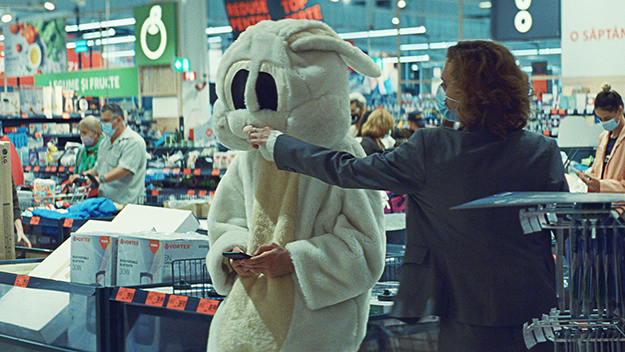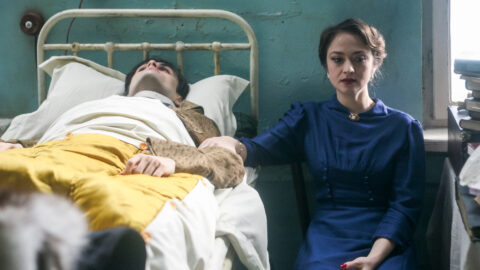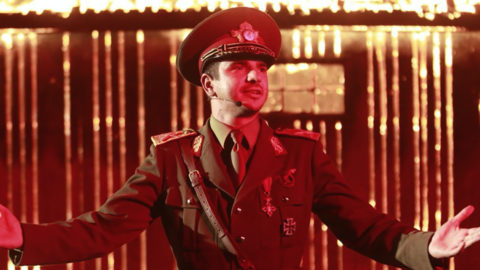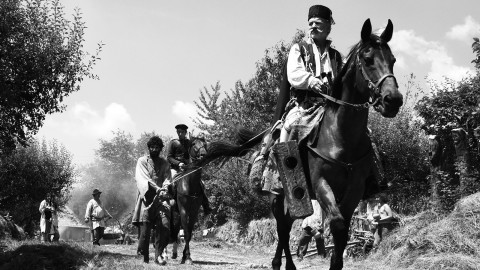I Like It Deep
This article appeared in the November 18 edition of The Film Comment Letter, our free weekly newsletter featuring original film criticism and writing. Sign up for the Letter here.

Bad Luck Banging or Loony Porn (Radu Jude, 2021)
A rumbling: truth
itself has appeared
among humankind
in the very thick of their
flurrying metaphors.
-Paul Celan
Midway through Radu Jude’s Golden Bear–winning Bad Luck Banging or Loony Porn, the narrative is interrupted by a glossary of terms. Ideas like “Church,” “Children,” and “Blowjob,” are explicated in a procession of skits, gags, archival footage, and static images, each accompanied by a kind of caption. For “Truth,” Jude uses Paul Celan’s poem Ein Dröhnen (“A rumbling”), which describes truth’s messianic arrival in the human world—it stretches out its long legs and descends into the the Metapherngestöber, one of the poet’s frequent neologisms. Michael Hamburger translates the word as “flurrying metaphors,” but in the film, the subtitles have it as “metaphor-flurry.” It’s a subtle but potent difference: while the former imagines a world traversed by metaphors, the latter posits that our world is constituted by them—that we exist within a kind of storm (some translations use “squall” instead of “flurry”) that uproots meanings and violently scatters them about.
“Metaphor-flurry” is also an apt description for Loony Porn, which functions foremost as iconoclasm. (From the Greek: eikōn, likeness; klan, break.) Jude plays with meaning-making in provocative ways, and not just in the aforementioned lexiconical chapter, “A short dictionary of anecdotes, signs, and wonders.” That bravura middle section is bookended by two long segments detailing the story of Emilia (Katia Pascariu), a history teacher whose sex tape—made for personal use—is uploaded to the internet against her will.
The first chapter follows Emi as she navigates a labyrinthine Bucharest, scampering back and forth across the frame as Jude’s camera drifts up and down and left and right, taking in the city’s cacophony of capitalistic signs. In a general store, images of Jesus Christ are seen alongside those of characters from the The Emoji Movie; pamphlets for politicians are scattered on the streets and noisy signs for money exchange line storefronts; on a billboard, a woman’s face is sprayed suggestively with milk, and a caption furthers the suggestion: “I like it deep!” Jude lingers on each image just long enough for it to become a kind of sight gag. As his camera pokes around this otherwise uninteresting urban landscape, isolating each piece of iconography, a certain silliness compounds. By the time we encounter the man on the street selling “zipper repair,” everything—from ersatz Greek statues to baby-bearing Barbies—appears as an absurd joke, bereft of meaning. It is fitting, then, that the chapter ends with an oxymoronic act: Emi sitting down to take her anti-anxiety medication with a cup of coffee—uppers and downers, a chemical Escher.
Within the Metapherngestöber of contemporary life, the world is in disarray. The busy streets of Bucharest are marred by endless construction projects and public ructions, reflecting a state of dysfunction where people coalesce but no longer cohere. While Emi stands in line at a grocery store, a woman paying with food stamps is heckled by the woman behind her to hurry up. The cashier steps in and is scolded for not opening another check-out. “That’s not my job,” she explains, to which the impatient shopper sarcastically replies: “It’s never anyone’s fault, we’re all innocent.” These exchanges only become more vitriolic. When Emi asks a man to move his massive pickup truck from the middle of the sidewalk, he responds, “Suck my cock! I’ll fuck your mother!” She calls him an “asshole” and leaves. For no reason at all, an elderly woman approaches the camera, smiling, and says, “Eat my cunt!” Later, we hear offscreen: “Fuck off, faggot, I’ll run you over!” and then see a car ram a man off his feet.
It is no accident that violence and sex entwine insidiously in these offhand exchanges. Loony Porn’s central conceit—the leaking of Emi’s tape—displaces sex from its context of private pleasure. As the film unfolds, Jude brings into view a world where sex is made public in pernicious ways: not just commercialized but actively weaponized. In the film’s final chapter, Emi is put on trial by her students’ parents and the administrators of her school. Though opprobrium abounds during this carnivalesque town hall, it is never quite clear what Emi has done wrong. She is not to blame for the video being available online, nor for students watching it. Once this is established, the parents—all caricatures: a priest, a military general, an overtly patriarchal pilot—begin to make their true reservations known. For the crimes of “cocksucking” and doing it “doggy-style,” as the parents put it, Emi is a whore, and must be punished.
The subjugation of sexual freedom—particularly, the violent control of reproduction—defines some of the darkest times in Romania’s history. Communist Romania legalized abortion in 1957, nearly two decades earlier than the United States. (Lenin had legalized the right for a woman “to control her own body” in 1920.) But Nicolae Ceauşescu banned abortion shortly after coming to power in 1965, and Romania saw the highest maternal and infant mortality rates in Europe. Families were fined for not having children, women were subjected to mandatory fertility inspections, and illegal abortions became the most common form of contraception. While these historical specifics are not invoked explicitly in Loony Porn, Jude contrives a world where Romania’s fascistic past, repressed and distorted by state and citizens alike, seeps from the nation’s pores like poison.
While Jude’s “short dictionary of anecdotes, signs, and wonders” is frequently played for laughs, its canny word-image juxtapositions elucidate important and often glossed-over matters of historical fact: that the Romanian church has always aligned itself with power, even when citizens were being slaughtered in the streets; that the country’s fascist roots run deep; and, of course, that the country, an ally of Nazi Germany from 1940 to 1944, was complicit in the horrors of the Holocaust. The section on “History” is accompanied by the caption: “The contemplation of history is more likely to inspire, if not contempt for humanity, then a somber vision of the world.” At its core, this middle chapter is a history lesson.
In the film’s final section Emi—who teaches, well, history—takes the stand as an embattled emissary of truth, attempting to reason with the acrid illogic of her peers. The parents accuse Emi of “indoctrinating” their children by teaching them about Romania’s involvement in the Holocaust and assigning The Diary of Anne Frank. The bigotry at the heart of such denialism is quickly laid bare: to the incessant refrain of Woody Woodpecker’s cackle, blaring from a parent’s phone, Emi is called a “kike” and accused of being funded by Bill Gates and George Soros. The reference to these two bêtes noires of the anti-semitic right expands the scope of the film’s critique to a world gone mad. Let us not forget that here in the United States, a recent state bill was passed that prohibits educators from discussing “controversial” historical, social, or political issues. Should these subjects arise, the bill states, teachers must explore them “from diverse and contending perspectives.” If Emi were to teach The Diary of Anne Frank not in Bucharest but in the supposedly liberal-democratic state of Texas, she might have to, as Francine Prose notes in a recent op-ed in The Guardian, give credence to the “perspective” of someone like Ditlieb Felderer, author of Anne Frank’s Diary: A Hoax, who calls the book “the first pedophile pornographic work to come out after World War II.”
While truth may be the enemy of fascism, what that truth looks like is not always so clear. We expect it to appear as something legible, possessed of indisputable clarity, but as Celan’s poem reminds us, it sometimes makes itself known in strange and unfamiliar ways, with a shape and sound we do not or cannot understand. By placing it within the dizzying crosswinds of the Metapherngestöber, Celan presents truth as a metaphor amid metaphors, one of many images—be that a teacher’s sex tape or a young girl’s diary—awaiting interpretation. Jude has a similar idea. To define “Cinema,” the film refers to the myth of Perseus and Medusa, in which the hero uses Athena’s shield as a mirror to safely see the gorgon and cut off its head. A silent image of snow falling at night is paired with onscreen text paraphrasing Siegfried Kracauer: “The moral is that we do not, and cannot, see actual horrors because they paralyze us with blinding fear; and that we shall know what they look like only by watching images which reproduce their appearance… The cinema screen is Athena’s polished shield.”
James Wham is a writer based in New York. His work has appeared in The Baffler, Cineaste, and Reverse Shot.







